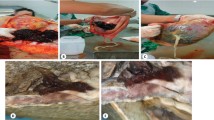Abstract
Placenta percreta is the abnormal invasion of the placenta through the myometrium and serosa of the uterus. It is the most invasive of the placenta accreta spectrum followed by placenta increta. This paper presents a case of a maternal and fetal death in the second trimester due to rupture of the uterus at the site of placenta percreta in a C-section scar. Postmortem MRI showed a large hemoperitoneum and thinning of the anterolateral uterine wall. Internal examination revealed two liters of blood in the abdomen and rupture of the anterolateral uterine wall at the site of placenta percreta in a previous C-section scar. Placenta percreta is a rare complication of pregnancy, however, it is becoming more common with the increasing rate of C-section, the most common and significant risk factor.





Similar content being viewed by others
References
Garmi G, Salim R. Epidemiology, etiology, diagnosis, and management of placenta accreta. Obstet Gynecol Int. 2012;2012:873929.
Farooq F, Siraj R, Raza S, Saif N. Spontaneous uterine rupture due to placenta percreta in a 17-week twin pregnancy. J Coll Physicians Surg Pak. 2016;26:121–3.
Clark S, Koonings P, Phelan J. Placenta previa/accreta and prior cesarean section. Obstet Gynecol. 1985;66:89–92.
Hornemann A, Bohlmann M, Diedrich K, Kavallaris A, Kehl S, Kelling K, et al. Spontaneous uterine rupture at the 21st week of gestation caused by placenta percreta. Arch Gynecol Obstet. 2011;284:875–8.
Wu S, Kocherginsky M, Hibbard J. Abnormal placentation: twenty-year analysis. Am J Obstet Gynecol. 2005;192:1458–61.
Ulkumen B, Pala H, Baytur Y. Acute abdomen and massive hemorrhage due to placenta percreta leading to spontaneous uterine rupture in the second trimester. Saudi Med J. 2014;35:1131–2.
Wozniak S, Kłudka-Sternik M, Czuczwar P, Szkodziak P, Paszkowski M, Paszkowski T. Placenta percreta leading to uterine rupture at 18 weeks of pregnancy with consecutive hysterectomy: a case report. Ginekol Pol. 2013;84:318–20.
Sahu R, Raut V, Sewlikar V, Jain N. Spontaneous rupture of uterus in a primigravida at 26 weeks of gestation with placenta previa and percreta. J Obstet Gynaecol India. 2016;66:717–9.
Anand A, Gupta S, Gupta A. Placenta percreta causing spontaneous rupture of the uterus. J Obstet Gynaecol India. 2013;63:64–5.
O'Brien J, Barton J, Donaldson E. The management of placenta percreta: conservative and operative strategies. Am J Obstet Gynecol. 1996;175:1632–8.
D'antonio F, Iacovella C, Palacios-Jaraquemada J, Bruno CH, Manzoli L, Bhide A. Prenatal identification of invasive placentation using magnetic resonance imaging: systematic review and meta-analysis. Ultrasound Obstet Gynecol. 2014;44:8–16.
Kilcoyne A, Shenoy-Bhangle AS, Roberts DJ, Sisodia RC, Gervais DA, Lee SI. MRI of placenta accreta, placenta increta, and placenta percreta: pearls and pitfalls. Am J Roentgenol. 2017;208:214–21.
Placenta accreta. Committee opinion no. 529. American College of Obstetricians and Gynecologists. Obstet Gynecol. 2012;120:207–11.
Jauniaux ER, Alfirevic Z, Bhide AG, Belfort MA, Burton GJ, Collins SL, et al. Placenta praevia and placenta accreta: diagnosis and management: green-top guideline no. 27a. BJOG. 2019;126:e1.
Acknowledgements
Special thanks to Dr. Michael Pickup, Dawn Thorpe, Jennifer Clement, Maureen Currie, Yolanda Nerkowski, and Andy King for their contributions to post-mortem imaging and photography.
Author information
Authors and Affiliations
Corresponding author
Ethics declarations
Ethical approval
Ethics approval was not required for this case report.
Conflict of interest
The authors declare that they have no conflicts of interest.
Informed consent
Not applicable.
Additional information
Publisher’s note
Springer Nature remains neutral with regard to jurisdictional claims in published maps and institutional affiliations.
Rights and permissions
About this article
Cite this article
Bradley, L.M., Addas, J.A.K. & Herath, J.C. Maternal and fetal death at 22 weeks following uterine rupture at the site of the placenta percreta in a C-section scar. Forensic Sci Med Pathol 15, 658–662 (2019). https://doi.org/10.1007/s12024-019-00130-5
Accepted:
Published:
Issue Date:
DOI: https://doi.org/10.1007/s12024-019-00130-5




